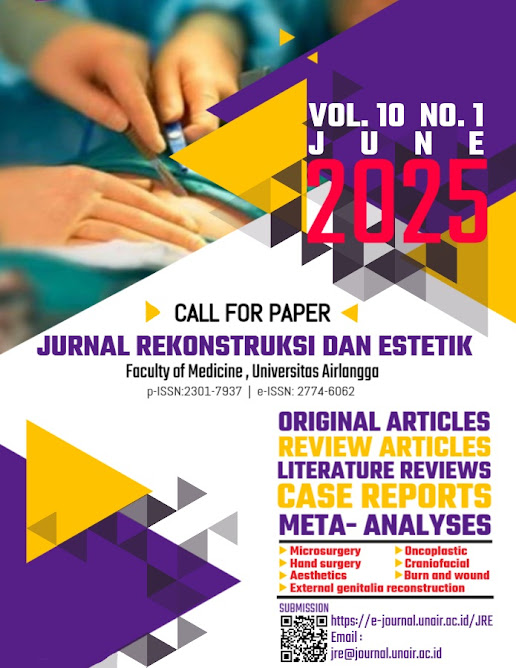WELCOME TO JURNAL REKONSTRUKSI DAN ESTETIK
WELCOME TO JURNAL REKONSTRUKSI DAN ESTETIK Faculty of Medicine, Universitas Airlangga ISSN International Center | p-ISSN:2301-793...
CALL FOR PAPERS VOL. 10 NO. 1 JUNE 2025
JURNAL REKONSTRUKSI DAN ESTETIK VOL.9 NO.2 DECEMBER 2024
Scarring is an inherent part of the body’s natural healing process after trauma or injury. However, for many individuals, scars can become more than just cosmetic concerns—they can affect functionality and quality of life. Hypertrophic and keloid scars, in particular, are a complex issue, often resulting from atypical wound healing responses. These scars are characterized by an overproduction of connective tissue and can be challenging to treat. In Indonesia, there has been limited data on the clinical profile and management strategies for hypertrophic scars. This gap in research prompted a study conducted at Dr. Soetomo General Academic Hospital in Surabaya, focusing on hypertrophic scars and their treatment methods.
This descriptive study, published in the Jurnal Rekonstruksi dan Estetik, used retrospective analysis of medical records from patients treated for hypertrophic scars at Dr. Soetomo General Academic Hospital from 2019 to 2020. By examining various variables—such as age, gender, occupation, cause of the scar, anatomical location, size, and treatment interventions—the study aimed to better understand the factors influencing hypertrophic scars and to inform more effective treatment strategies.
From 2019 to 2020, 68 patients were treated for hypertrophic scars at the hospital. A few key findings stood out:
Age and Gender: The majority of patients were young adults, aged between 17 and 25 years. The gender distribution was nearly equal, with 50% male and 50.9% female patients.
Cause of Scars: Burns were the most common cause of hypertrophic scars, accounting for 37.5% of cases, followed by other forms of trauma at 25%. Burns not only result in physical injury but also leave long-lasting scars, often in visible areas of the body.
Scar Locations: The most common areas affected by hypertrophic scars were the face (25%) and upper extremities (25%), two areas that are highly visible and crucial for functionality.
Scar Size: The majority of scars measured between 1 to 5 cm² (25%), which suggests that many cases involved moderate-sized injuries that can be managed effectively with the right therapeutic intervention.
Treatment Methods: Surgical techniques were the most widely used approach for treating hypertrophic scars, with 80% of patients receiving surgical intervention and 48% undergoing specific surgical procedures to remove or minimize the scars.
The results of this study emphasize the significance of early intervention in managing hypertrophic scars, particularly for individuals affected by burns. While the aesthetic impact of scars is immediately noticeable, their functional consequences—such as restricted movement or discomfort—can be just as significant. Treatment methods, including surgical approaches, are often necessary to minimize the effects of hypertrophic scarring and improve the patient’s quality of life.
This study provides valuable insight into the clinical profile and management of hypertrophic scars, particularly in young adults and students. The research highlights that burns are the leading cause of hypertrophic scars, with the face and upper extremities being the most affected areas. Surgical techniques remain the primary treatment method for these scars.
Understanding the factors influencing hypertrophic scars is crucial for advancing treatment options and improving patient outcomes. With more research and data collection, healthcare professionals can develop more tailored approaches for managing and treating hypertrophic scars.
For a deeper dive into the study and its findings, read the full article https://doi.org/10.20473/jre.v9i2.65031
Read more other articles: Jurnal Rekonstruksi dan Estetik
Stay informed and explore the latest developments in scar management by reading and citing this important research!
#SurgicalInnovation #AestheticSurgery #MedicalResearch #JREUNAIR #HealthCare #PlasticSurgery #Hypertrophicscars #scarmanagement #clinicalprofile #woundhealingJURNAL REKONSTRUKSI DAN ESTETIK VOL.9 NO.2 DECEMBER 2024
HELMET USE COMPLIANCE SURVEY FOR CRANIOFACIAL TRAUMA PREVENTION AMONG MOTORCYCLISTS IN JAYAPURA CITY RING ROAD
Compliance with helmet use by motorcycle riders and passengers is a crucial factor in preventing craniofacial and head injuries. This study aims to assess and evaluate the level of helmet use compliance among motorcyclists and passengers on the ring road in Jayapura City, emphasizing the importance of helmet use in protecting against potential head trauma.
This time-based survey observed motorcycle riders and passengers on the Jayapura City ring road over a 14-day period, during three time intervals (morning, afternoon, and evening). The collected data were analyzed descriptively to evaluate compliance with helmet use and the associated risks of injury.
During the study, a total of 6,411 motorcycles passed through the ring road. The survey revealed that 18,602 motorcycle riders and passengers were at moderate risk of injury due to not wearing helmets (MR-IV), while 11,849 individuals were at high risk (HR-II). The peak of non-compliance occurred during the afternoon (T3) period, where 71.92% of the HR-V group, 84.82% of the HR-II group, and 290.15% of the MR-IV group failed to wear helmets.
The findings suggest that helmet use compliance among motorcycle riders and passengers on the Jayapura Ring Road is alarmingly low, significantly increasing the risk of head injuries in the event of an accident. These results highlight the urgent need for public health strategies to encourage helmet use and reduce non-compliance, particularly during peak traffic times. Further research is essential to evaluate helmet use compliance on other major roads in Jayapura to gain a more comprehensive understanding of the issue.
Explore this insightful study on helmet use compliance in Jayapura City, shedding light on critical factors influencing head injury prevention. Dive into the data and discover key findings that highlight the need for improved safety measures. Don't miss out—read and cite this important research today!
For more related articles, visit: Jurnal Rekonstruksi dan Estetik
Read more: https://doi.org/10.20473/jre.v9i2.64397
#SurgicalInnovation #AestheticSurgery #MedicalResearch #JREUNAIR #HealthCare #PlasticSurgery #Motorcycleaccident #helmet #headinjury #craniofacialinjuries #publichealth #injuryprevention





